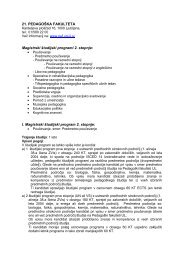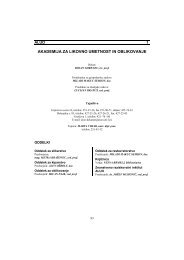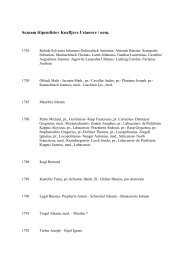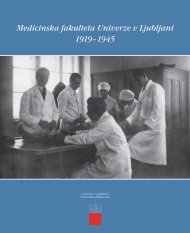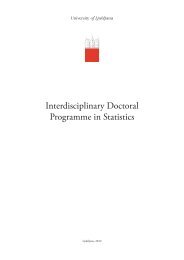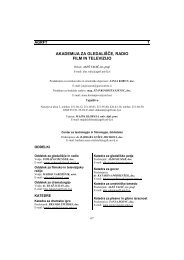Uravnavanje izražanja genov, transkriptomika in drugi pristopi po ...
Uravnavanje izražanja genov, transkriptomika in drugi pristopi po ...
Uravnavanje izražanja genov, transkriptomika in drugi pristopi po ...
Create successful ePaper yourself
Turn your PDF publications into a flip-book with our unique Google optimized e-Paper software.
Podiplomski študij Biomedic<strong>in</strong>e<br />
Genetika: Genetski koncepti (2010-011)<br />
<strong>Uravnavanje</strong> <strong>izražanja</strong> <strong>genov</strong>, <strong>transkriptomika</strong> <strong>in</strong><br />
<strong>drugi</strong> <strong>pristopi</strong> <strong>po</strong>-genomskega obdobja<br />
1. Osnove uravnavanje <strong>izražanja</strong> <strong>genov</strong>.<br />
Prof. dr. Damjana Rozman<br />
Damjana.rozman@mf.uni-lj.si<br />
http://cfgbc.mf.uni-lj.si/<br />
2. Študije genoma <strong>in</strong> transkriptoma z DNA mikromrežami (čipi).<br />
3. Študije genoma <strong>in</strong> transkriptoma z novo generacijo sekveniranja.<br />
4. Pomen <strong>in</strong>formatike pri študijah “omov”.
1. Osnove uravnavanje <strong>izražanja</strong> <strong>genov</strong> pri evkariontih
Bakterije<br />
– 1 RNA <strong>po</strong>limeraza<br />
Evkarionti<br />
– RNA <strong>po</strong>l I (45s pre-rRNA )<br />
-RNA <strong>po</strong>l II (mRNA kodirani geni, miRNA)<br />
-RNA <strong>po</strong>l III (tRNA, 5S rRNA)
RNA <strong>po</strong>limeraza se lahko premika v obe smeri
Model of the <strong>po</strong>l II transcription <strong>in</strong>itiation complex with the addition<br />
of electron microscope structures of TFIIE, TFIIF, and TFIIH.<br />
Bushnell et al., Science 303, 983-988 (2004)
Splošni transkripcijski faktorji RNA <strong>po</strong>limeraze II<br />
n TFIID: velik multiprote<strong>in</strong>ski kompleks, ki prične sestavljanje<br />
transkripcijskega aparata. Vsebuje TBP <strong>in</strong> TAFe<br />
n TFIIB: <strong>in</strong>teragira z TBP <strong>in</strong> z DNA (analog bakterijskih σ faktorjev)<br />
n TFIIF: udeležen pri <strong>in</strong>iciaciji kot pri <strong>po</strong>daljševanju verige.<br />
n TFIIE: veže TFIIH<br />
n TFIIH ima k<strong>in</strong>azno aktivnost, je helikaza, sodeluje tudi pri <strong>po</strong>pravljanja<br />
DNA. Predstavlja <strong>po</strong>vezavo med prepisovanjem <strong>in</strong> <strong>po</strong>pravljanjem DNA <strong>in</strong><br />
uravnavanjem celičnega cikla.<br />
n TFIIA - <strong>po</strong> nekaterih izsledkih ne spada med splošne transkripcijske<br />
faktorje temveč med specializirane TFIID koaktivatorje. V <strong>po</strong>gojih <strong>in</strong> vitro<br />
veže TBP-DNA kompleks <strong>in</strong> <strong>po</strong>vzroči širjenje DNA-prote<strong>in</strong> kontaktov,<br />
obstajajo pa tudi dokazi, da ima <strong>po</strong>men le pri kontaktiranju z genskospecifičnimi<br />
transkripcijskimi faktorji.
Molekularni dogodki pri izražanju <strong>genov</strong> pri evkariontih<br />
Prenos<br />
signala<br />
Razdružitev<br />
nukleosomov<br />
Prostorsko<br />
raz<strong>po</strong>rejanje<br />
DNA<br />
30 nm vlakno<br />
Premik nukleosomov s<br />
tkivno-specifičnimi<br />
faktorji<br />
Pre<strong>in</strong>iciacijski<br />
kompleks<br />
Aktivatorji<br />
prepisovanja<br />
<strong>po</strong>lII<br />
10 nm vlakno
The chromosome territory–<strong>in</strong>terchromat<strong>in</strong> compartment (CT–IC) model<br />
Lanctôt et al. Nature Reviews Genetics 8, 104–115 (February 2007) | doi:10.1038/nrg2041<br />
Chromat<strong>in</strong> is organized <strong>in</strong> dist<strong>in</strong>ct CTs. Nuclear to<strong>po</strong>graphy rema<strong>in</strong>s a subject<br />
of debate, expecially with regard to the extent of chromat<strong>in</strong> loops expand<strong>in</strong>g<br />
<strong>in</strong>to the IC and <strong>in</strong>term<strong>in</strong>gl<strong>in</strong>g between neighbour<strong>in</strong>g CTs and chromosomal<br />
subdoma<strong>in</strong>s.
Chromat<strong>in</strong> mobility allows dynamic <strong>in</strong>teractions between genomic loci and<br />
between loci and other nuclear structures.<br />
a) Movement of chromat<strong>in</strong> from one<br />
compartment to another leads to changes <strong>in</strong><br />
expression of the corres<strong>po</strong>nd<strong>in</strong>g genomic<br />
regions.<br />
Activation is triggered by re<strong>po</strong>sition<strong>in</strong>g of the<br />
gene loci to an activat<strong>in</strong>g compartment, away<br />
from silenc<strong>in</strong>g compartments.<br />
b) Compartments are transient self-organiz<strong>in</strong>g<br />
entities.<br />
Gene activation leads to dissolution of the<br />
silenc<strong>in</strong>g compartments, changes <strong>in</strong> gene<br />
<strong>po</strong>sition<strong>in</strong>g and de novo assembly of an<br />
activat<strong>in</strong>g compartment.<br />
Lanctôt et al. Nature Reviews Genetics 8, 104–115 (February 2007) | doi:10.1038/nrg2041
•Osnovni aparat – RNA <strong>po</strong>limeraza<br />
Transkripcijski aparat<br />
•Regulatorji (aktivatorji, represorji; trans-delujoči faktorji)<br />
Cis-elementi<br />
•Cis-regulatorni moduli (CRM); vz<strong>po</strong>dbujevalci (enhacers), utiševalci (silencers)<br />
http://the_bra<strong>in</strong>.bwh.harvard.edu/Lever/Lever.png
Struktura gena razreda <strong>po</strong>l II
Tipični <strong>po</strong>l II gen ima promotor, ki zavzema <strong>po</strong>dročje cca 200 bp navzgor<br />
od mesta pričetka prepisovanja. Lahko vsebuje tudi <strong>po</strong>speševalec<br />
(enhancer), ki je oddaljen <strong>po</strong>ljubno.<br />
Lew<strong>in</strong>, GenesVII
The core promoter:<br />
Core promoter-selective RNA <strong>po</strong>lymerase II<br />
transcription<br />
-m<strong>in</strong>imal DNA region that is sufficient to direct low levels of activator-<strong>in</strong>dependent (basal)<br />
transcription by RNAP II <strong>in</strong> vitro;<br />
-typically extends approx. 40 bp up- and downstream of the start site of transcription;<br />
-can conta<strong>in</strong> several dist<strong>in</strong>ct core promoter sequence elements;<br />
-conta<strong>in</strong>s TATA box or INR (<strong>in</strong>itiator) element.<br />
Computational analysis of metazoan genomes suggests that the prevalence of the<br />
TATA box has been overestimated <strong>in</strong> the past and that the majority of human genes<br />
are TATA-less.<br />
While TATA-mediated transcription <strong>in</strong>itiation has been studied <strong>in</strong> great detail and is very<br />
well understood, very little is known about the factors and mechanisms <strong>in</strong>volved <strong>in</strong> the<br />
function of the INR and other core promoter elements.<br />
Biochem Soc Symp. 2006;(73):225-36.
TATA-less promoters<br />
Mol<strong>in</strong>a and Grotewold BMC Genomics 2005 6:25
Transkripcijski cikel
Komunikacija med CRM <strong>in</strong> promotorjem
Kromat<strong>in</strong> <strong>in</strong> prepisovanje<br />
http://www.wadsworth.org/images/bio_icons/tn_transchromat<strong>in</strong>.jpg
N-term<strong>in</strong>alni repki histonov so gibljivi <strong>in</strong> obrnjeni navzven.<br />
Modifikacija histonskih repkov vodi do strukturnih<br />
sprememb, <strong>po</strong>trebnih pri pričetku prepisovanja<br />
GenesVII
Potranslacijske spremembe histonov<br />
določajo strukturo kromat<strong>in</strong>a<br />
Acetilacija (HAT) <strong>po</strong>meni aktivacijo.<br />
Deacetilacija (HDAC) je <strong>in</strong>aktivacija.<br />
Pomen metilacije je odvisen od konteksta.<br />
www.med.ufl.edu/biochem/ keithr/fig1pt2.html
Povzetek I: RNA <strong>po</strong>limeraze, osnovni aparat <strong>in</strong> cikel transkripcije,<br />
kromat<strong>in</strong><br />
•Transkripcijo katalizirajo evolucijsko ohranjene RNA <strong>po</strong>limeraze. Evkarionti imajo<br />
RNA <strong>po</strong>I I, II <strong>in</strong> III. Potrebni pa so še <strong>drugi</strong> prote<strong>in</strong>i (RNA <strong>po</strong>limeazni kompleks).<br />
•Če <strong>po</strong>limeraza naleti na oviro, se lahko premakne nazaj (back-track<strong>in</strong>g).<br />
•Cis regulatorni moduli CRM preko vezave transkripcijskih faktorjev sodelujejo z<br />
RNA <strong>po</strong>limeraznim kompleksom.<br />
•Cikel transkripcije vsebuje začetek (<strong>in</strong>iciacijo), <strong>po</strong>daljševanje (elongacijo) <strong>in</strong><br />
zaključek (term<strong>in</strong>acijo).<br />
•TBP je univerzalni transkripcijski faktor, ki pre<strong>po</strong>zna TATA, <strong>po</strong>treben pa je tudi za<br />
prepisovanje s promotorjev brez TATA.<br />
•Potranslacijske spremembe histonov določajo strukturo kromat<strong>in</strong>a <strong>in</strong> s tem<br />
prepisovanje oziroma utišanje <strong>genov</strong>.
2. Študije transkriptoma z DNA mikromrežami (čipi),<br />
<strong>po</strong>vezave z <strong>drugi</strong>mi “omi”<br />
The suffix “-ome-” orig<strong>in</strong>ated as a back-formation from “genome”, a word formed<br />
<strong>in</strong> analogy with “chromosome”.<br />
Because “genome” refers to the complete genetic makeup of an organism, some<br />
people have made the <strong>in</strong>ference that there exists some root, *“-ome-”, of Greek<br />
orig<strong>in</strong> referr<strong>in</strong>g to wholeness or to completion.<br />
Because of the success of large-scale quantitative biology projects such as<br />
genome sequenc<strong>in</strong>g, the suffix "-ome-" has migrated to a host of other contexts.<br />
Bio<strong>in</strong>formaticians and molecular biologists figured amongst the first scientists to<br />
start to apply the "-ome" suffix widely.<br />
http://en.wikipedia.org/
The “ome” world<br />
http://en.wikipedia.org/<br />
The transcriptome, the mRNA complement of an entire organism, tissue type, or cell;<br />
with its associated field transcriptomics<br />
The metabolome, the totality of metabolites <strong>in</strong> an organism; with its associated field<br />
metabolomics<br />
The metallome, the totality of metal and metalloid species; with its associated field<br />
metallomics<br />
The lipidome, the totality of lipids; with its associated field Lipidomics<br />
The glycome, the totality of glycans, carbohydrate structures of an organism, a cell or tissue type. Glycomics:<br />
The associated field of study.<br />
The <strong>in</strong>teractome, the totality of the molecular <strong>in</strong>teractions <strong>in</strong> an organism a once pro<strong>po</strong>sed field of<br />
<strong>in</strong>teractomics has generally become known as systems biology<br />
The spliceome (see spliceosome), the totality of the alternative splic<strong>in</strong>g prote<strong>in</strong> isoforms; with its associated<br />
field spliceomics.<br />
The ORFeome refers to the totality of DNA sequences that beg<strong>in</strong> with the <strong>in</strong>itiation codon ATG, end with a<br />
nonsense codon, and conta<strong>in</strong> no stop codon. Such sequences may therefore encode part or all of a prote<strong>in</strong>.<br />
The Phenome - the organism itself. The Phenome is to the genome what the phenotype is to the genotype.<br />
Also, the complete list of phenotypic mutants available for a species.<br />
The Ex<strong>po</strong>some - the collection of an <strong>in</strong>dividual's environmental ex<strong>po</strong>sures.
Genomics<br />
http://en.wikipedia.org/<br />
Genomics is the study of an organism's entire genome.<br />
The field <strong>in</strong>cludes <strong>in</strong>tensive efforts to determ<strong>in</strong>e the entire DNA sequence of<br />
organisms and f<strong>in</strong>e-scale genetic mapp<strong>in</strong>g efforts.<br />
http://www.wiley.com/legacy/college/boyer/0470003790/cutt<strong>in</strong>g_edge/shotgun_seq/computer.gif
A DNA microarray<br />
A DNA microarray (also commonly known as gene chip, DNA chip, or biochip) is a<br />
collection of microscopic DNA s<strong>po</strong>ts attached to a solid surface, such as glass, plastic or<br />
silicon chip form<strong>in</strong>g an array for the pur<strong>po</strong>se of monitor<strong>in</strong>g of expression levels for<br />
thousands of genes simultaneously.<br />
The affixed DNA segments are known as probes (although some sources will use different<br />
nomenclature), thousands of which can be used <strong>in</strong> a s<strong>in</strong>gle DNA microarray.<br />
Microarray technology evolved from Southern blott<strong>in</strong>g, where fragmented DNA is attached<br />
to a substrate and then probed with a known gene or fragment.<br />
Measur<strong>in</strong>g gene expression us<strong>in</strong>g microarrays is relevant to many areas of biology and<br />
medic<strong>in</strong>e, such as study<strong>in</strong>g treatments, disease, and developmental stages. For example,<br />
microarrays can be used to identify disease genes by compar<strong>in</strong>g gene expression <strong>in</strong><br />
disease and normal cells.
DNA čipi (DNA mikromreže)<br />
• Analiza genoma (genotpizacija enojnih nukleotidnih <strong>po</strong>limorfizmov SNP,<br />
analiza variance števila kopij CNV oz. CGH).<br />
• Analiza transkriptoma (ekspresijsko profiliranje: 3' ekspresijski, eksonski ali<br />
genski čipi, čipi za sledenje <strong>izražanja</strong> miRNA).<br />
• Študije uravnavanja <strong>izražanja</strong> <strong>genov</strong> (kromat<strong>in</strong>ska imunoprecipitacija na čipu<br />
ChIP-on-Chip, mapiranje prepisov).
Robust, simple representation<br />
focus<strong>in</strong>g on the 3' ends.<br />
Different parts of the gene as probes on the array<br />
Genome-wide, exon-level analysis<br />
on a s<strong>in</strong>gle array —<br />
a survey of alternative splic<strong>in</strong>g and<br />
gene expression.<br />
High-density tiled microarrays for<br />
transcript mapp<strong>in</strong>g.<br />
http://www.affymetrix.com/products/arrays/<strong>in</strong>dex.affx
Hybridization: Watson-Crick base pair<strong>in</strong>g; AT(U), GC
Hybridization on the microarray<br />
http://www.ieee.org/<strong>po</strong>rtal/cms_docs_sscs/sscs/07Fall/HamFig1s.jpg
Detekcija signala <strong>po</strong> hibridizaciji DNA či<strong>po</strong>v
Methods of detection of differences at the genome level<br />
• Mendelian Genetics,<br />
• Direct DNA Sequenc<strong>in</strong>g,<br />
• RFLP analysis,<br />
– Restriction Fragment Length Polymorphism,<br />
• Allele Specific Oligonucleotides,<br />
• DNA Microarrays<br />
• Novel generation of high-throughput sequenc<strong>in</strong>g
Genotyp<strong>in</strong>g microarrays<br />
DNA microarrays can be used to read the sequence of a genome <strong>in</strong> particular<br />
<strong>po</strong>sitions.<br />
SNP microarrays are a particular type of DNA microarrays that are used to<br />
identify genetic variation <strong>in</strong> <strong>in</strong>dividuals and across <strong>po</strong>pulations.<br />
Short oligonucleotide arrays can be used to identify the s<strong>in</strong>gle nucleotide<br />
<strong>po</strong>lymorphisms (SNPs) that are thought to be res<strong>po</strong>nsible for genetic variation<br />
and the source of susceptibility to genetically caused diseases.<br />
Amplifications and deletions can also be detected us<strong>in</strong>g comparative genomic<br />
hybridization <strong>in</strong> conjuction with microarrays.<br />
Resequenc<strong>in</strong>g arrays have also been developed to sequence <strong>po</strong>rtions of the genome <strong>in</strong> <strong>in</strong>dividuals. These arrays may<br />
be used to evaluate germl<strong>in</strong>e mutations <strong>in</strong> <strong>in</strong>dividuals, or somatic mutations <strong>in</strong> cancer.<br />
Genome til<strong>in</strong>g arrays <strong>in</strong>clude overlapp<strong>in</strong>g oligonucleotides designed to blanket an entire genomic region of <strong>in</strong>terest. Many<br />
companies have successfully designed til<strong>in</strong>g arrays that cover whole human chromosomes.
If every human genome is different, what does it mean to sequence<br />
"the" human genome?<br />
The complete human genome sequence announced <strong>in</strong> June 2000 is a<br />
"representative" genome sequence based on the DNA of just a few<br />
<strong>in</strong>dividuals.<br />
Over the longer term, scientists will study DNA from many different people to<br />
identify where and what variations between <strong>in</strong>dividual genomes exist.<br />
Sequenc<strong>in</strong>g a genome is such a Herculean task that captur<strong>in</strong>g its person-toperson<br />
variability on the first pass would be next to im<strong>po</strong>ssible.<br />
S<strong>in</strong>ce every person's genome is unique, no one person is any more or less<br />
"representative" than any other and it hardly matters whose genome is<br />
sequenced first.<br />
The vast majority of the genome's sequence is the same from one person to<br />
the next, with the same genes <strong>in</strong> the same places.<br />
www.genomenewsnetwork.org/.../ Chp4_1.shtml
Why is every human genome different?<br />
Where are genome variations found?<br />
What k<strong>in</strong>ds of genome variations are there?
DNA Polymorphism<br />
…a DNA locus that has two or more sequence variations, each present at a frequency of 1%<br />
or more <strong>in</strong> a <strong>po</strong>pulation,<br />
– 1 <strong>in</strong> 700 frequency common <strong>in</strong> most species,<br />
– less than 1 million loci <strong>in</strong> humans (1 <strong>in</strong> 3,000).<br />
Most SNPs have only two alleles<br />
The human genome conta<strong>in</strong>s more than 2 million SNPs.
DNA preparation for SNP array analysis
SNP chips<br />
To determ<strong>in</strong>e which alleles are present, genomic DNA from an <strong>in</strong>dividual is isolated, fragmented,<br />
tagged with a fluorescent dye, and applied to the chip.<br />
The genomic DNA fragments anneal only to these oligos to which they are perfectly<br />
complementary.<br />
A computer reads the <strong>po</strong>sition of the two fluorescent tags and identifies the <strong>in</strong>dividual as a C / T<br />
heterozygote.<br />
The s<strong>in</strong>gle s<strong>po</strong>ts <strong>in</strong> the other three columns <strong>in</strong>dicate that the <strong>in</strong>dividual is homozygous at the three<br />
corres<strong>po</strong>nd<strong>in</strong>g SNP <strong>po</strong>sitions.<br />
http://www.mun.ca/biology/scarr/DNA_VDA_chip_schematic.jpg
Pharmacogenomics pr<strong>in</strong>ciple: To identify patients at risk for toxicity or<br />
reduced res<strong>po</strong>nse to therapy for optimal medication and/or dose selection
Comparative genomic hybridization<br />
Array comparative genomic hybridization (CGH) is a tool for the assessment of DNA<br />
copy number variation (CNV) with<strong>in</strong> any given DNA sample.<br />
The technique is derived from the concept of conventional CGH where patient and<br />
reference DNA (the latter derived from a normal male/female) is differentially labelled<br />
and co-hybridized to a normal metaphase spread.
Some diseases are associated with sections of chromosomes that are<br />
erroneously replicated or deleted.<br />
The technique of array-based genomic hybridisation (array-comparative<br />
genomic hybridization CGH or copy number variation CNV) allows highthroughput,<br />
rapid identification and mapp<strong>in</strong>g of these genomic DNA copy<br />
number changes, with higher resolution than is <strong>po</strong>ssible us<strong>in</strong>g traditional,<br />
non-array methods.<br />
http://www.nature.com/lab<strong>in</strong>vest/journal/v85/n9/images/3700312f2.jpg
Ekspresijsko profiliranje z DNA mikromrežami
Gene Expression (expression profil<strong>in</strong>g)<br />
General Scheme:<br />
1) Extract mRNA,<br />
2) synthesize labeled cDNA,<br />
3) Hybridize with DNA on the array,<br />
4) Scan (image analysis)<br />
5) look for genes that are expressed similarly (normalization, cluster<strong>in</strong>g,<br />
<strong>in</strong>formatics)
Parts of a gene represented <strong>in</strong> different types of microarrays
Exon arrays – example I<br />
Complex organisation and structure of the ghrel<strong>in</strong> antisense strand gene GHRLOS, a candidate noncod<strong>in</strong>g<br />
RNA gene<br />
Seim I et al., BMC Molecular Biology 2008, 9:95
Short oligonucleotides from 3’-end
Example for <strong>in</strong>sights <strong>in</strong>to disease: comb<strong>in</strong>ation of expression profil<strong>in</strong>g and CGH<br />
http://www.genomictree.com/images/bioimg09.jpg
miRNA Profil<strong>in</strong>g<br />
MicroRNAs (miRNAs) are 21-23 nucleotide long non-cod<strong>in</strong>g RNA molecules that have<br />
regulate the stability or translational efficiency of target messenger RNAs.<br />
The expected number of miRNA <strong>in</strong> humans is over 800 (Sanger Institute mirBase<br />
database)<br />
miRNA genes regulate prote<strong>in</strong> production for at least 10% of human genes.
miRNA isolation<br />
The start<strong>in</strong>g material is total RNA (not small RNA) by isolated with i.e. TRIZOL still conta<strong>in</strong><strong>in</strong>g small<br />
RNA molecules. As such, they should not have been cleaned up us<strong>in</strong>g columns as this will<br />
<strong>in</strong>variably remove the small RNAs which the arrays are try<strong>in</strong>g to measure. Just 100ng of total RNA is<br />
required for labell<strong>in</strong>g. Once isolated, samples can be quantified us<strong>in</strong>g the Nanodrop Spectrophotometer.<br />
Because miRNAs are so short, they are less prone to degradation then mRNAs and it has been<br />
tentatively shown that good data can be obta<strong>in</strong>ed from Formal<strong>in</strong> Fixed Paraf<strong>in</strong> Embedded (FFPE)<br />
tissue. Total RNA quality can be checked on the Agilent 2100 Bioanalyser to ensure no degradation of<br />
larger RNA molecules has occurred.<br />
Screen capture of Agilent 2100 Bioanalyzer electropherograms of a TRIZOL Reagent isolated total RNA. Note the<br />
pronounced peak of RNA at
Hybridiation of miRNA microarrays<br />
The 5' hairp<strong>in</strong> on each probe provides excellent size discrim<strong>in</strong>ation.<br />
The label<strong>in</strong>g protocol adds a Cy3-Cytos<strong>in</strong>e<br />
residue to the 3' end of miRNAs. This, coupled<br />
with the <strong>in</strong>clusion of Guan<strong>in</strong>e residue at the 5'<br />
end of the probe, <strong>in</strong>creases the stability of<br />
b<strong>in</strong>d<strong>in</strong>g to labeled target miRNAs.<br />
Source: Agilent
Chromat<strong>in</strong>e immunoprecipitation on a chip (CHIP-Chip)
The Chip protocol<br />
proteomics.swmed.edu
The "ChIP to Chip" Assay<br />
The DNA fragments co-immunoprecipitated with the prote<strong>in</strong> of <strong>in</strong>terest are<br />
amplified by ligat<strong>in</strong>g l<strong>in</strong>kers to the ends of the DNA fragments.<br />
The amplified material is then annealed to a DNA microarray conta<strong>in</strong><strong>in</strong>g the<br />
appropriate probes.<br />
This is often done with two colors, the other be<strong>in</strong>g the total DNA as a control.<br />
Any DNA enriched <strong>in</strong> the immunoprecipitation above the level of the total is<br />
scored as a site of prote<strong>in</strong> b<strong>in</strong>d<strong>in</strong>g.<br />
proteomics.swmed.edu
Chip-chip – example I<br />
Detection of Nkx2-5 b<strong>in</strong>d<strong>in</strong>g to the Actc1 promoter and <strong>in</strong>tron 1 (A) and the Nppa promoter (B)<br />
us<strong>in</strong>g the Integrated Genome Browser<br />
www.nimr.mrc.ac.uk/devbiol/mohun/cardiacdiff/
DNA čipi so zbirka mikroskopskih “DNA točk”, cDNA ali oligonukleotidov, pritrjenih<br />
na trdo <strong>po</strong>dlago.<br />
U<strong>po</strong>rabljajo se za:<br />
Povzetek<br />
• Analizo genomske DNA (genotipizacija, SNP analiza, CHG, sekvenciranje).<br />
• Analizo <strong>izražanja</strong> <strong>genov</strong> (ekspresijsko profiliranje) , kjer probe lahko<br />
predstavljajo 3'–konce <strong>genov</strong>, eksone ali različne dele <strong>genov</strong>. Posebni čipi pa<br />
so za sledenje <strong>izražanja</strong> miRNA.<br />
• Študije uravnavanja <strong>izražanja</strong> <strong>genov</strong> (določanje vezavnih mest<br />
transkripcijskih faktorjev, metilacija kromat<strong>in</strong>a), kjer probe predstavljajo 5’neprevedene<br />
dele <strong>in</strong> nerepetitivne dele <strong>genov</strong>.
Nova generacija sekvenciranja<br />
www.gatc.co.uk/cgi-b<strong>in</strong>/wPr<strong>in</strong>tpreview.cgi?sour...
Nova (naslednja) generacija sekvenciranja<br />
- Sekvenciranje človeškega genoma je trajalo več let, z u<strong>po</strong>rabo cca 20 kb BAC klonov, ki so<br />
vsebovali cca 100 kb dolge tarčne fragmente, <strong>in</strong> 8-kratnega <strong>po</strong>krivanja vsakega dela tarče. Analiza s<br />
kapilarno elektroforezo.<br />
-Nadaljnji razvoj sekvenciranja je temeljil na sočasnem sekvenciranju celotnega genoma (WHS, angl.<br />
whole genome sequenc<strong>in</strong>g), ki je bil vstavljen v vektorje. Metoda je hitrejša, pušča pa velike prazn<strong>in</strong>e<br />
v zelo <strong>po</strong>limorfnih ali repetitivnih genomih. Analiza je <strong>po</strong>tekala s kapilarno elektroforezo.<br />
-Naslednja generacija sekvenciranja (2004) – visokozmogljivostno paralelno čitanje odsekov DNA na<br />
ravni celega genoma preko PCR <strong>po</strong>množevanja enoverižnih fragmentov genomske knjižnice.
Nature, 24. oktober 2010
Next-generation of DNA and RNA sequenc<strong>in</strong>g methods<br />
- The bead-amplification sequenc<strong>in</strong>g (Roche/454FLX)<br />
-Sequenc<strong>in</strong>g by synthesis (Illum<strong>in</strong>a/Solexa Genome analyzer)<br />
-Sequenc<strong>in</strong>g by ligation (Applied Biosystems SOLID System)<br />
-Helicos Helioscope (2008)<br />
-Pacific Biosciences SMRT (2010)<br />
Common features:<br />
-A compex <strong>in</strong>terplay of enzymology, chemistry, software, hardware, optics eng<strong>in</strong>eer<strong>in</strong>g…)<br />
-A streaml<strong>in</strong>e of sample preparation prior to sequenc<strong>in</strong>g (time sav<strong>in</strong>g)<br />
-Preparation of fragment libraries of the DNA of <strong>in</strong>terest by anneal<strong>in</strong>g for platform-specific l<strong>in</strong>kers<br />
and amplification<br />
-Amplification of s<strong>in</strong>gle stranded fragment library and perform<strong>in</strong>g sequenc<strong>in</strong>g on amplified<br />
fragments<br />
-S<strong>in</strong>gle molecule sequenc<strong>in</strong>g just arrived or is under development
Classical Sanger dideoxy sequenc<strong>in</strong>g method<br />
Dideoxynucleotide sequenc<strong>in</strong>g represents only one method of<br />
sequenc<strong>in</strong>g DNA. It is commonly called Sanger sequenc<strong>in</strong>g s<strong>in</strong>ce<br />
Sanger devised the method. This technique utilizes 2',3'dideoxynucleotide<br />
triphospates (ddNTPs), molecules that differ<br />
from deoxynucleotides by the hav<strong>in</strong>g a hydrogen atom attached<br />
to the 3' carbon rather than an OH group. These molecules<br />
term<strong>in</strong>ate DNA cha<strong>in</strong> elongation because they cannot form a<br />
phosphodiester bond with the next deoxynucleotide.<br />
campus.queens.edu/faculty/jannr/molecular/
General concepts for clonal-array generation and sequenc<strong>in</strong>g<br />
a | Bead-chips. Genomic DNA is fragmented and adaptors are ligated to create<br />
an <strong>in</strong>sert library that is flanked by two universal prim<strong>in</strong>g sites. This library is<br />
cloned on beads us<strong>in</strong>g emulsion PCR technology. Beads with clones are aff<strong>in</strong>ity<br />
selected and assembled onto a planar substrate. A subsequent cycle-sequenc<strong>in</strong>g<br />
reaction is used to read out the sequence on the clones (illum<strong>in</strong>a)<br />
b | Sequenc<strong>in</strong>g by synthesis (SBS). A common anchor primer is annealed to a<br />
constant sequence (universal prim<strong>in</strong>g site) that is conta<strong>in</strong>ed with<strong>in</strong> the library<br />
clones. The sequence is read out by <strong>po</strong>lymerase extension <strong>in</strong> a base-by-base<br />
fashion (pyrosequenc<strong>in</strong>g). After <strong>in</strong>cor<strong>po</strong>ration of a s<strong>in</strong>gle base or base type, the<br />
<strong>in</strong>cor<strong>po</strong>rated base is identified by fluorescence (laser) or chemilum<strong>in</strong>escence (no<br />
laser required). (Roche)<br />
c | Sequenc<strong>in</strong>g by ligation. The array set-up is similar to SBS <strong>in</strong> which a<br />
common primer is annealed to an arrayed library and used to read out the<br />
sequence through a stepwise ligation of random oligomers. After read-out of each<br />
ligation event, the primer and the ligated oligomer are stripped, a new primer<br />
reannealed and the process repeated with an oligomer that conta<strong>in</strong>s a query<br />
base at a different <strong>po</strong>sition. (ABI)<br />
Fan et al. Nature Reviews Genetics 7, 632–644 (August 2006) | doi:10.1038/nrg1901
Sequenc<strong>in</strong>g by<br />
synthesis<br />
Solexa / illum<strong>in</strong>a<br />
General concepts for clonal-array generation and sequenc<strong>in</strong>g<br />
Bead chips<br />
Roche<br />
pyrosequenc<strong>in</strong>g<br />
Sequenc<strong>in</strong>g by<br />
Ligation<br />
Applied biosystems<br />
Fan et al. Nature Reviews Genetics 7, 632–644 (August 2006) | doi:10.1038/nrg1901
Roche/454 FLX Pyrosequencer<br />
Library fragments are mixed with agarose<br />
beads with oligos complementary to<br />
adapter sequences on the library.<br />
Each bead is associated with a s<strong>in</strong>gle<br />
fragment.<br />
Each fragment-bead complex is isolated<br />
<strong>in</strong>to <strong>in</strong>dividual oil:water micelles with PCR<br />
mixture.<br />
Thermal cycl<strong>in</strong>g of this emulsion PCR of<br />
the micelles produces amplified unique<br />
sequences on the bead surface.<br />
“En mass” sequenc<strong>in</strong>g of PCR products<br />
on picotiter plates (PTP) with s<strong>in</strong>gle beads<br />
<strong>in</strong> each picowell.<br />
Enzyme/substrate conta<strong>in</strong><strong>in</strong>g beads for<br />
the pyrosequenc<strong>in</strong>g reaction are added to<br />
wells that act as floww cells for addition of<br />
<strong>in</strong>dividual pure nucleotide solutions. The<br />
CCD camera records the light emitted at<br />
each bead.
Pr<strong>in</strong>ciples of Pyrosequenc<strong>in</strong>g<br />
A sequenc<strong>in</strong>g primer is hybridized to a s<strong>in</strong>gle-stranded PCR<br />
amplicon that serves as a template.<br />
A s<strong>in</strong>gle dNTP is added at each time.<br />
Mixtures are <strong>in</strong>cubated with the enzymes, DNA<br />
<strong>po</strong>lymerase, ATP sulfurylase, luciferase, and apyrase as<br />
well as the substrates, adenos<strong>in</strong>e 5' phosphosulfate (APS),<br />
and lucifer<strong>in</strong>.<br />
ATP sulfurylase converts PPi to ATP <strong>in</strong> the presence of<br />
adenos<strong>in</strong>e 5' phosphosulfate (APS).<br />
ATP drives the luciferase-mediated conversion of<br />
lucifer<strong>in</strong> to oxylucifer<strong>in</strong> that generates visible light <strong>in</strong><br />
amounts that are pro<strong>po</strong>rtional to the amount of ATP.<br />
Apyrase, a nucleotide-degrad<strong>in</strong>g enzyme, cont<strong>in</strong>uously<br />
degrades un<strong>in</strong>cor<strong>po</strong>rated nucleotides and ATP. When<br />
degradation is complete, another nucleotide is added<br />
Light signal is detected only when the proper dNTP is<br />
<strong>in</strong>cor<strong>po</strong>rated,<br />
pyrogram
Watson and Cricks pyrosequenc<strong>in</strong>g readout<br />
2008
sequenc<strong>in</strong>g by synthesis
Illum<strong>in</strong>a sequence - decod<strong>in</strong>g
Nova generacija sekvenciranja - <strong>po</strong>vzetek<br />
• Nova generacija visokozmogljivostnega sekvenciranje omogoča raz<strong>po</strong>znavanje za<strong>po</strong>redij<br />
DNA na ravni celega genoma, z resolucijo <strong>po</strong>sameznega baznega para.<br />
• Iz vsakega vzorca se pripravi z adaptorji ligirana knjižnica, ki vsebuje vse v vzorcu<br />
prisotne fragmente DNA ali RNA (cDNA).<br />
• Vse platforme bazirajo na ligaciji adaptorjev <strong>in</strong> <strong>po</strong>množevanju, imajo pa različne pristope<br />
sekvenciranja:<br />
-Pirosekvenciranje (Roche-Nimblegen)<br />
-Sekvenciranje s s<strong>in</strong>tezo (Illum<strong>in</strong>a-Solexa)<br />
-Sekvenciranje z ligacijo (ABI)<br />
•Razvijajo se tudi metode, ki pred sekvenciranjem ne <strong>po</strong>trebujejo <strong>po</strong>množevanja.<br />
• Aplikacije so enake kot pri klasičnih mikromrežah (ekspresijsko profiliranje oz. SAGE,<br />
genotipizacija SNP <strong>in</strong> CNV, kroamt<strong>in</strong>ska imunoprecipitacija, metilacija kromat<strong>in</strong>a, itd.).<br />
•Prednost pred klasičnimi mikromrežami je v preprosti pripravi vzorca <strong>in</strong> zmožnosti<br />
procesiranja velikega števila vzorcev v kratkem času.<br />
•Procesiranje velikega števila vzorcev na eni ali več aparaturah lahko upravlja en človek.
Bio<strong>in</strong>formatika v raziskavah “omov”<br />
http://bio<strong>in</strong>formatics.ubc.ca/about/what_is_bio<strong>in</strong>formatics/images/computer.gif<br />
www.gwumc.edu
http://www.uni-leipzig.de/
Obta<strong>in</strong><strong>in</strong>g Reliable Data from “ome” Experiments – Standardization and beyond
Steps <strong>in</strong> <strong>po</strong>st-genome experiments<br />
Consult bio<strong>in</strong>formatician<br />
Requested bio<strong>in</strong>formatician<br />
Consult bio<strong>in</strong>formatician<br />
irfgc.irri.org/cropbio<strong>po</strong>rtal/<strong>in</strong>dex.php?option...
Bio<strong>in</strong>formatics<br />
Wikipedia<br />
Mak<strong>in</strong>g sense of the huge amounts of DNA data produced by gene sequenc<strong>in</strong>g<br />
projects.<br />
Bio<strong>in</strong>formatics and computational biology <strong>in</strong>volve the use of techniques from<br />
applied mathematics, <strong>in</strong>formatics, statistics, and computer science to solve biological<br />
problems.<br />
Research <strong>in</strong> computational biology often overlaps with systems biology.<br />
Major research efforts <strong>in</strong> the field <strong>in</strong>clude sequence alignment, gene f<strong>in</strong>d<strong>in</strong>g, genome<br />
assembly, prote<strong>in</strong> structure alignment, prote<strong>in</strong> structure prediction, prediction of gene<br />
expression and prote<strong>in</strong>-prote<strong>in</strong> <strong>in</strong>teractions, and the model<strong>in</strong>g.<br />
The terms bio<strong>in</strong>formatics and computational biology are often used <strong>in</strong>terchangeably,<br />
although the former typically focuses on algorithm development and specific<br />
computational methods, while the latter focuses more on hy<strong>po</strong>thesis test<strong>in</strong>g and<br />
discovery <strong>in</strong> the biological doma<strong>in</strong>.
Microarrays and bio<strong>in</strong>formatics<br />
Standardization<br />
The lack of standardization <strong>in</strong> arrays presents an <strong>in</strong>teroperability problem <strong>in</strong><br />
bio<strong>in</strong>formatics, which h<strong>in</strong>ders the exchange of array data.<br />
Various projects are attempt<strong>in</strong>g to facilitate the exchange and analysis of data<br />
produced with non-proprietary chips.<br />
The "M<strong>in</strong>imum Information About a Microarray Experiment" (MIAME) XML<br />
based standard for describ<strong>in</strong>g a microarray experiment is be<strong>in</strong>g adopted by<br />
many journals as a requirement for the submission of papers <strong>in</strong>cor<strong>po</strong>rat<strong>in</strong>g<br />
microarray results.<br />
http://www.mged.org/Workgroups/MIAME/miame.html
Statistical analysis<br />
The analysis of DNA microarrays <strong>po</strong>ses a large number of statistical problems,<br />
<strong>in</strong>clud<strong>in</strong>g the normalisation of the data.<br />
From a hy<strong>po</strong>thesis-test<strong>in</strong>g perspective, the large number of genes present on a<br />
s<strong>in</strong>gle array means that the experimenter must take <strong>in</strong>to account a multiple<br />
test<strong>in</strong>g problem: even if each gene is extremely unlikely to randomly yield a<br />
result of <strong>in</strong>terest, the comb<strong>in</strong>ation of all the genes is likely to show at least one<br />
or a few occurrences of this result which are false <strong>po</strong>sitives.
Data m<strong>in</strong><strong>in</strong>g <strong>in</strong>cludes gene ontology<br />
Gene ontology is a controlled vocabulary used to describe the biology of a<br />
gene product <strong>in</strong> any organism. There are 3 <strong>in</strong>dependent sets of vocabularies,<br />
or ontologies, that describe the:<br />
-molecular function of a gene product,<br />
- the biological process <strong>in</strong> which the gene product participates,<br />
-and the cellular com<strong>po</strong>nent where the gene product can be found.
Experimental design is crucial for a succesfull “omic” experiment<br />
A proper experimental design is crucial for obta<strong>in</strong><strong>in</strong>g useful conclusions from a project. The choice of<br />
design ideally <strong>in</strong>cludes an assessment of the biological variation, the technical variation, the cost and<br />
duration of the experiment, and the availability of biological material. The experimental design can also<br />
depend on the methods that will be used to analyse the data afterwards. In certa<strong>in</strong> cases, the<br />
parameters needed to f<strong>in</strong>d the optimal design must be obta<strong>in</strong>ed by a pilot experiment.<br />
A related problem is the comparison of different compet<strong>in</strong>g experimental methods or devices. Here, a<br />
proper test design is crucial as well to be able to make a firm conclusion <strong>in</strong> favor of one or the other<br />
method.<br />
Dere E. et al., BMC Genomics 2006, 7:80doi<br />
lunabiosciences.com/experimentaldesign.html
Experimenal design – an example<br />
Changes <strong>in</strong> cholesterol homeostasis and drug metabolism caused by different factors <strong>in</strong> mouse liver<br />
T. Rezen et al., BMC Genomics 2008, 9:76
Pomen bio<strong>in</strong>formatike v raziskavh “omov” - <strong>po</strong>vzetek<br />
- Matematično-<strong>in</strong>formatični <strong>pristopi</strong> v bioloških <strong>po</strong>skusih <strong>po</strong>genomske dobe (bio<strong>in</strong>formatika)<br />
omogočajo razbiranje biološkega smisla v enormni količ<strong>in</strong>i <strong>po</strong>datkov.<br />
-Bio<strong>in</strong>formatika (računska biologija, matematična biologija) za reševanje bioloških problemov<br />
u<strong>po</strong>rablja metode u<strong>po</strong>rabne matematike, <strong>in</strong>formatike, statistike <strong>in</strong> računalniških znanosti.<br />
-Dobro načrtovanje bioloških <strong>po</strong>skusov zahteva sodelovanje eksperimentatorjev <strong>in</strong><br />
<strong>in</strong>formatikov že od vsega začetka.<br />
-Zasnova <strong>po</strong>skusa zahteva def<strong>in</strong>icijo biolškega vprašanja, izbiro platforme za analizo,<br />
določitev števila bioloških (<strong>in</strong> tehničnih) <strong>po</strong>novitev <strong>in</strong> načrt serije <strong>po</strong>skusov (hibridizacij ali<br />
sekvenciranj).<br />
-Po tehnični izvedbi <strong>po</strong>skusa sledita statistična <strong>in</strong> <strong>in</strong>formatična obdelava ter rudarjenje<br />
<strong>po</strong>datkov.<br />
- Statistično-<strong>in</strong>formatična obdelava obsega ekstrakcijo <strong>in</strong>tenzitet signala, normalizacijo<br />
<strong>po</strong>datkov ter različne statistične teste, da pridobimo listo diferencialno izraženih <strong>genov</strong> ali<br />
listo za<strong>po</strong>redij DNA.<br />
- Sekundarna <strong>in</strong>formatična analiza <strong>in</strong> rudarjenje <strong>po</strong>datkov obsegata gručanje <strong>in</strong><br />
raz<strong>po</strong>znavanje vzorcev, študije seznama <strong>genov</strong> z genskimi ontologijami, iskanje regulatornih<br />
vzorcev, kot tudi načrtovanje validacijskih eksperimentov.<br />
-Matematično-<strong>in</strong>formatične metode za <strong>po</strong>vezovanje <strong>po</strong>datkov različnih “omov” (npr.<br />
transkriptom, proteom, metabolom) so še v razvoju.



